A Coupled Tensor–DEM–FEM Model for the Whole Process of Internal Fine-Scale Damage to Surface Damage in Red-Bed Soft Rocks in the Coastal Area of South China
Abstract
:1. Introduction
2. Research Contents and Methods
2.1. Visualization Test of Red-Bed Soft Rock Triaxial Compression Disaster
2.2. FJM of Meso-Damage Evolution in Red-Bed Soft Rock
2.2.1. Flat-Joint Model
2.2.2. Acoustic Emission Mechanism
2.3. Tensor Model of Surface Damage Caused by Internal Damage in Red-Bed Soft Rock
2.3.1. Moment Tensor Method
2.3.2. Three-Dimensional Stress-Fabric Analysis
2.4. DEM–FEM Coupling Model for the Whole Process of Red-Bed Soft Rock Disaster
3. Results and Discussion
3.1. Three-Dimensional Visualization Test of Multifield Coupling Damage of Red-Bed Soft Rock with High Time–Space Resolution in the Whole Process
3.1.1. Laboratory Test Results
3.1.2. Digital Image (DIC) Analysis
3.1.3. DIC Full-Field Strain Analysis
3.2. Analysis of the Results of the Tensor–DEM–FEM Coupling Model for the Whole Process of Damage and Disaster of Red-Bed Soft Rock
3.2.1. Analysis of Meso-Damage Results in Red-Bed Soft Rock
3.2.2. Analysis of the Results of Internal Damage and Surface Damage in Red-Bed Soft Rock
3.2.3. Verification of the Whole Process of Damage and Disaster in Red-Bed Soft Rock
3.3. Discussion of Research Results
3.3.1. Calibration Method of FJM
3.3.2. Analysis of the Disaster Damage Index of Red-Bed Soft Rock
4. Conclusions
- (1)
- On the basis of the tensor–DEM–FEM linked model, the whole process of internal fine-scale damage to surface damage in red-bed soft rock was obtained. The early damage occurs in the elastic stage, and the local strain begins to spiral out of control during the crack acceleration stage. Tensile damage information has the highest distribution frequency in the final damage process, indicating that the growth of tensile-type fine-scale damage is primarily controlling the damage process.
- (2)
- It was found that the overall acoustic emission intensity distribution of the internal microscopic damage and surface damage correlation of red-bed soft rocks is [−8.5, −6.3] in 2D and [−11, −9] in 3D; the highest intensity of acoustic emission frequency is −7.4 in 2D and 1.74 in 3D; the b-value of the damage acceleration feature is 1.22 and 1.74, respectively, in 2D and 3D; and the R-value is mutated in the vicinity of the DIC results, which accord with the results of the indoor test.
- (3)
- The approach described in this study for estimating and defining the entire process of internal fine-scale damage to surface damage is a new reference for understanding different sorts of rock damage processes that is not confined and may be applied to other fields such as mining.
Author Contributions
Funding
Institutional Review Board Statement
Informed Consent Statement
Data Availability Statement
Conflicts of Interest
References
- Liu, Z.; Zhou, C.; Li, B.; Zhang, L.; Liang, Y. Effects of grain dissolution-diffusion sliding and hydro-mechanical interaction on the creep deformation of soft rocks. Acta Geotech. 2020, 15, 1219–1229. [Google Scholar] [CrossRef]
- Yu, L.; Lai, H.; Zhou, C.; Liu, Z.; Zhang, L. Percolation Threshold of Red-Bed Soft Rock during Damage and Destruction. Appl. Sci. 2022, 12, 7615. [Google Scholar] [CrossRef]
- Xue, Y.; Ma, X.; Qiu, D.; Yang, W.; Li, X.; Kong, F.; Zhou, B.; Qu, C. Analysis of the factors influencing the nonuniform deformation and a deformation prediction model of soft rock tunnels by data mining. Tunn. Undergr. Space Technol. 2021, 109, 103769. [Google Scholar] [CrossRef]
- Liu, G.-Y.; Chen, Y.-L.; Du, X.; Azzam, R. A fractional viscoplastic model to predict the time-dependent displacement of deeply buried tunnels in swelling rock. Comput. Geotech. 2021, 129, 103901. [Google Scholar] [CrossRef]
- Bruning, T.; Karakus, M.; Nguyen, G.D.; Goodchild, D. An experimental and theoretical stress-strain-damage correlation procedure for constitutive modelling of granite. Int. J. Rock Mech. Min. Sci. 2019, 116, 1–12. [Google Scholar] [CrossRef]
- Xia, C.; Zhou, C.; Zhu, F.; Liu, Z.; Cui, G. The Critical Indicator of Red-Bed Soft Rocks in Deterioration Process Induced by Water Basing on Renormalization Group Theory. Appl. Sci. 2021, 11, 7968. [Google Scholar] [CrossRef]
- Shirole, D.; Hedayat, A.; Walton, G. Illumination of Damage in Intact Rocks by Ultrasonic Transmission-Reflection and Digital Image Correlation. J. Geophys. Res. Solid Earth 2020, 125, e2020JB019526. [Google Scholar] [CrossRef]
- Wevers, M.; Nicolaï, B.; Verboven, P.; Swennen, R.; Roels, S.; Verstrynge, E.; Lomov, S.; Kerckhofs, G.; Van Meerbeek, B.; Mavridou, A.M. Applications of CT for non-destructive testing and materials characterization. In Industrial X-ray Computed Tomography; Springer: Berlin/Heidelberg, Germany, 2018; pp. 267–331. [Google Scholar]
- Ju, Y.; Sun, H.; Xing, M.; Wang, X.; Zheng, J. Numerical analysis of the failure process of soil-rock mixtures through computed tomography and PFC3D models. Int. J. Coal Sci. Technol. 2018, 5, 126–141. [Google Scholar] [CrossRef]
- Shirole, D.; Walton, G.; Ostrovsky, L.; Masoumi, H.; Hedayat, A. Non-linear ultrasonic monitoring of damage progression in disparate rocks. Int. J. Rock Mech. Min. Sci. 2018, 111, 33–44. [Google Scholar] [CrossRef]
- Raziperchikolaee, S.; Alvarado, V.; Yin, S. Quantitative Acoustic Emissions Source Mechanisms Analysis of Soft and Competent Rocks through Micromechanics-Seismicity Coupled Modeling. Int. J. Geomech. 2021, 21, 04020269. [Google Scholar] [CrossRef]
- Kim, J.-S.; Kim, G.-Y.; Baik, M.-H.; Finsterle, S.; Cho, G.-C. A new approach for quantitative damage assessment of in-situ rock mass by acoustic emission. Geomech. Eng. 2019, 18, 11–20. [Google Scholar] [CrossRef]
- Holmes, J.; Sommacal, S.; Stachurski, Z.; Das, R.; Compston, P. Digital image and volume correlation with X-ray micro-computed tomography for deformation and damage characterisation of woven fibre-reinforced. Compos. Struct. 2022, 279, 114775. [Google Scholar] [CrossRef]
- Munoz, H.; Taheri, A.; Chanda, E.K. Pre-Peak and Post-Peak Rock Strain Characteristics During Uniaxial Compression by 3D Digital Image Correlation. Rock Mech. Rock Eng. 2016, 49, 2541–2554. [Google Scholar] [CrossRef]
- Lobanov, D.; Yankin, A.; Mullahmetov, M.; Chebotareva, E.; Melnikova, V. The Analysis of Stress Raisers Affecting the GFRP Strength at Quasi-Static and Cyclic Loads by the Theory of Critical Distances, Digital Image Correlation, and Acoustic Emission. Polymers 2023, 15, 2087. [Google Scholar] [CrossRef] [PubMed]
- Verstrynge, E.; De Wilder, K.; Drougkas, A.; Voet, E.; Van Balen, K.; Wevers, M. Crack monitoring in historical masonry with distributed strain and acoustic emission sensing techniques. Constr. Build. Mater. 2018, 162, 898–907. [Google Scholar] [CrossRef]
- Gong, F.; Zhang, P.; Xu, L. Damage constitutive model of brittle rock under uniaxial compression based on linear energy dissipation law. Int. J. Rock Mech. Min. Sci. 2022, 160, 105273. [Google Scholar] [CrossRef]
- Akdag, S.; Karakus, M.; Taheri, A.; Giang, N.; He, M. Effects of Thermal Damage on Strain Burst Mechanism for Brittle Rocks Under True-Triaxial Loading Conditions. Rock Mech. Rock Eng. 2018, 51, 1657–1682. [Google Scholar] [CrossRef]
- Sirdesai, N.N.; Singh, A.; Sharma, L.K.; Singh, R.; Singh, T.N. Determination of thermal damage in rock specimen using intelligent techniques. Eng. Geol. 2018, 239, 179–194. [Google Scholar] [CrossRef]
- Zhao, Z.; Peng, H.; Wu, W.; Chen, Y.-F. Characteristics of shear-induced asperity degradation of rock fractures and implications for solute retardation. Int. J. Rock Mech. Min. Sci. 2018, 105, 53–61. [Google Scholar] [CrossRef]
- Zhou, Z.; Zhao, C.; Cai, X.; Huang, Y. Three-dimensional modeling and analysis of fractal characteristics of rupture source combined acoustic emission and fractal theory. Chaos Solitons Fractals 2022, 160, 112308. [Google Scholar] [CrossRef]
- Arson, C. Micro-macro mechanics of damage and healing in rocks. Open Geomech. 2020, 2, 41. [Google Scholar] [CrossRef]
- Borrelli, L.; Ciurleo, M.; Gulla, G. Shallow landslide susceptibility assessment in granitic rocks using GIS-based statistical methods: The contribution of the weathering grade map. Landslides 2018, 15, 1127–1142. [Google Scholar] [CrossRef]
- Khayrutdinov, M.M.; Kongar-Syuryun, C.B.; Khayrutdinov, A.M.; Tyulyaeva, Y.S. Improving Safety when Extracting Water-soluble Ores by Optimizing the Parameters of the Backfill Mass. Bezop. Tr. V Promyshlennosti 2021, 53–59. [Google Scholar] [CrossRef]
- Adigamov, A.; Yudenkov, A. Stress-strain behavior model of disturbed rock mass with regard to anisotropy and discontinuities. Min. Inf. Anal. Bull 2021, 8, 93–103. [Google Scholar] [CrossRef]
- Meng, F.; Pu, H.; Sasaoka, T.; Shimada, H.; Liu, S.; Dintwe, T.K.M.; Sha, Z. Time effect and prediction of broken rock bulking coefficient on the base of particle discrete element method. Int. J. Min. Sci. Technol. 2021, 31, 643–651. [Google Scholar] [CrossRef]
- Vazaios, I.; Vlachopoulos, N.; Diederichs, M.S. Mechanical analysis and interpretation of excavation damage zone formation around deep tunnels within massive rock masses using hybrid finite-discrete element approach: Case of Atomic Energy of Canada Limited (AECL) Underground Research Laboratory (URL) test tunnel. Can. Geotech. J. 2019, 56, 35–59. [Google Scholar] [CrossRef]
- Xia, C.; Liu, Z.; Zhou, C. Burger’s Bonded Model for Distinct Element Simulation of the Multi-Factor Full Creep Process of Soft Rock. J. Mar. Sci. Eng. 2021, 9, 945. [Google Scholar] [CrossRef]
- Leclerc, W.; Haddad, H.; Guessasma, M. DEM-FEM coupling method to simulate thermally induced stresses and local damage in composite materials. Int. J. Solids Struct. 2019, 160, 276–292. [Google Scholar] [CrossRef]
- Mohammadnejad, M.; Dehkhoda, S.; Fukuda, D.; Liu, H.; Chan, A. GPGPU-parallelised hybrid finite-discrete element modelling of rock chipping and fragmentation process in mechanical cutting. J. Rock Mech. Geotech. Eng. 2020, 12, 310–325. [Google Scholar] [CrossRef]
- Saadat, M.; Taheri, A. A cohesive discrete element based approach to characterizing the shear behavior of cohesive soil and clay-infilled rock joints. Comput. Geotech. 2019, 114, 103109. [Google Scholar] [CrossRef]
- Gutierrez-Ch, J.G.; Senent, S.; Estebanez, E.; Jimenez, R. Discrete element modelling of rock creep behaviour using rate process theory. Can. Geotech. J. 2021, 58, 1231–1246. [Google Scholar] [CrossRef]
- Oladele, T.; Bbosa, L.; Weatherley, D. Textural and Mineralogical Controls on Rock Strength Elucidated Using a Discrete Element Method Numerical Laboratory. Minerals 2021, 11, 1015. [Google Scholar] [CrossRef]
- Lin, C.; Xia, C.; Zhang, H.; Liu, Z.; Zhou, C. Simulated Short- and Long-Term Deformation in Coastal Karst Caves. J. Mar. Sci. Eng. 2022, 10, 1315. [Google Scholar] [CrossRef]
- Lin, C.; Xia, C.; Liu, Z.; Zhou, C. A Comprehensive Correlation Study of Structured Soils in Coastal Area of South China about Structural Characteristics. J. Mar. Sci. Eng. 2022, 10, 508. [Google Scholar] [CrossRef]
- Saadat, M.; Taheri, A. A cohesive grain based model to simulate shear behaviour of rock joints with asperity damage in polycrystalline rock. Comput. Geotech. 2020, 117, 103254. [Google Scholar] [CrossRef]
- Yang, X.-X.; Qiao, W.-G. Numerical investigation of the shear behavior of granite materials containing discontinuous joints by utilizing the flat-joint model. Comput. Geotech. 2018, 104, 69–80. [Google Scholar] [CrossRef]
- Cheng, A.; Shu, P.; Deng, D.; Zhou, C.; Huang, S.; Ye, Z. Microscopic acoustic emission simulation and fracture mechanism of cemented tailings backfill based on moment tensor theory. Constr. Build. Mater. 2021, 308, 125069. [Google Scholar] [CrossRef]
- Zhao, Y.; Zhao, G.; Zhou, J.; Ma, J.; Cai, X. Failure mechanism analysis of rock in particle discrete element method simulation based on moment tensors. Comput. Geotech. 2021, 136, 104215. [Google Scholar] [CrossRef]
- Gilbert, F. A Discussion on the measurement and interpretation of changes of strain in the Earth-Derivation of source parameters from low-frequency spectra. Philos. Trans. R. Soc. A Math. Phys. Eng. Sci. 1973, 274, 369–371. [Google Scholar] [CrossRef]
- Feignier, B.; Young, R.P. Moment tensor inversion of induced microseismic events: Evidence of non-shear failures in the -4 < M < -2 moment magnitude range. Geophys. Res. Lett. 1992, 19, 1503–1506. [Google Scholar] [CrossRef]
- Ohtsu, M. Acoustic emission theory for moment tensor analysis. Res. Nondestruct. Eval. 1995, 6, 169–184. [Google Scholar] [CrossRef]
- Kongar-Syuryun, C.; Ubysz, A.; Faradzhov, V. Models and algorithms of choice of development technology of deposits when selecting the composition of the backfilling mixture. IOP Conf. Ser. Earth Environ. Sci. 2021, 684, 012008. [Google Scholar] [CrossRef]
- Xia, C.; Liu, Z.; Zhou, C.; Zhang, L. A Meso/Macroscale Theoretical Model for Investigating the Large Deformation of Soft Rock Tunnels Considering Creep and Anisotropic Effects. Rock Mech. Rock Eng. 2023, 56, 4901–4922. [Google Scholar] [CrossRef]
- Meng, Q.X.; Wang, H.L.; Xu, W.Y.; Cai, M.; Xu, J.; Zhang, Q. Multiscale strength reduction method for heterogeneous slope using hierarchical FEM/DEM modeling. Comput. Geotech. 2019, 115, 103164. [Google Scholar] [CrossRef]
- Chaudry, M.A.; Woitzik, C.; Duster, A.; Wriggers, P. A multiscale DEM-FEM coupled approach for the investigation of granules as crash-absorber in ship building. Comput. Part. Mech. 2022, 9, 179–197. [Google Scholar] [CrossRef]
- Zhou, Q.; Xu, W.-J.; Lubbe, R. Multi-scale mechanics of sand based on FEM-DEM coupling method. Powder Technol. 2021, 380, 394–407. [Google Scholar] [CrossRef]
- Cheng, Y.; Wong, L.N.Y. A study on mechanical properties and fracturing behavior of Carrara marble with the flat-jointed model. Int. J. Numer. Anal. Methods Geomech. 2020, 44, 803–822. [Google Scholar] [CrossRef]
- Li, B.; Guo, L.; Zhang, F.-s. Macro-micro investigation of granular materials in torsional shear test. J. Cent. South Univ. 2014, 21, 2950–2961. [Google Scholar] [CrossRef]
- Rong, H.; Li, G.; Liang, D.; Sun, C.; Zhang, S.; Sun, Y. Numerical Investigation on the Evolution of Mechanical Properties of Rock Affected by Micro-Parameters. Appl. Sci. 2020, 10, 4957. [Google Scholar] [CrossRef]
- Rybak, J.M.; Kongar-Syuryun, C.; Tyulyaeva, Y.; Khayrutdinov, A.M.; Akinshin, I. Geomechanical substantiation of parameters of technology for mining salt deposits with a backfill. Min. Sci. 2021, 28, 19–32. [Google Scholar] [CrossRef]
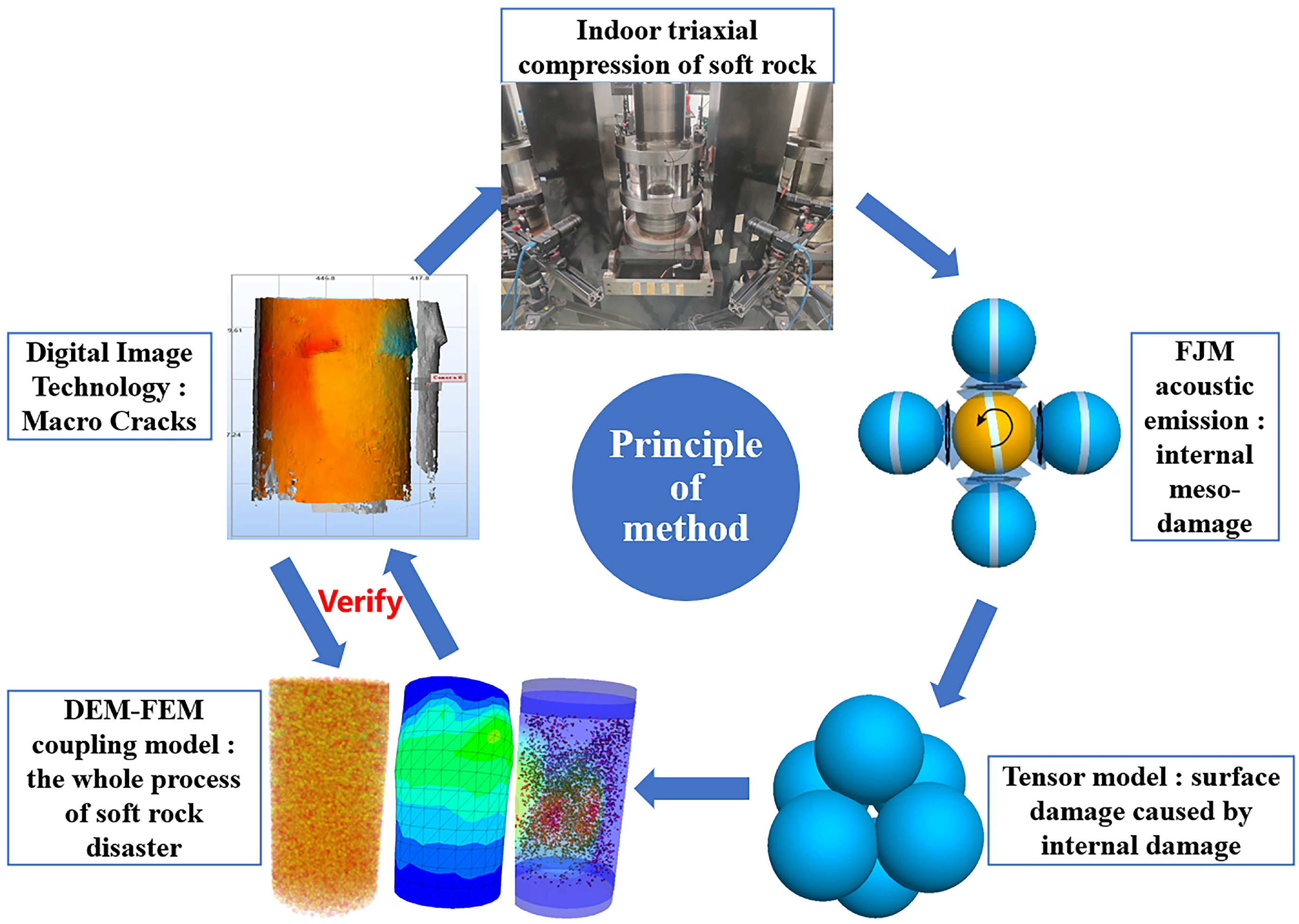

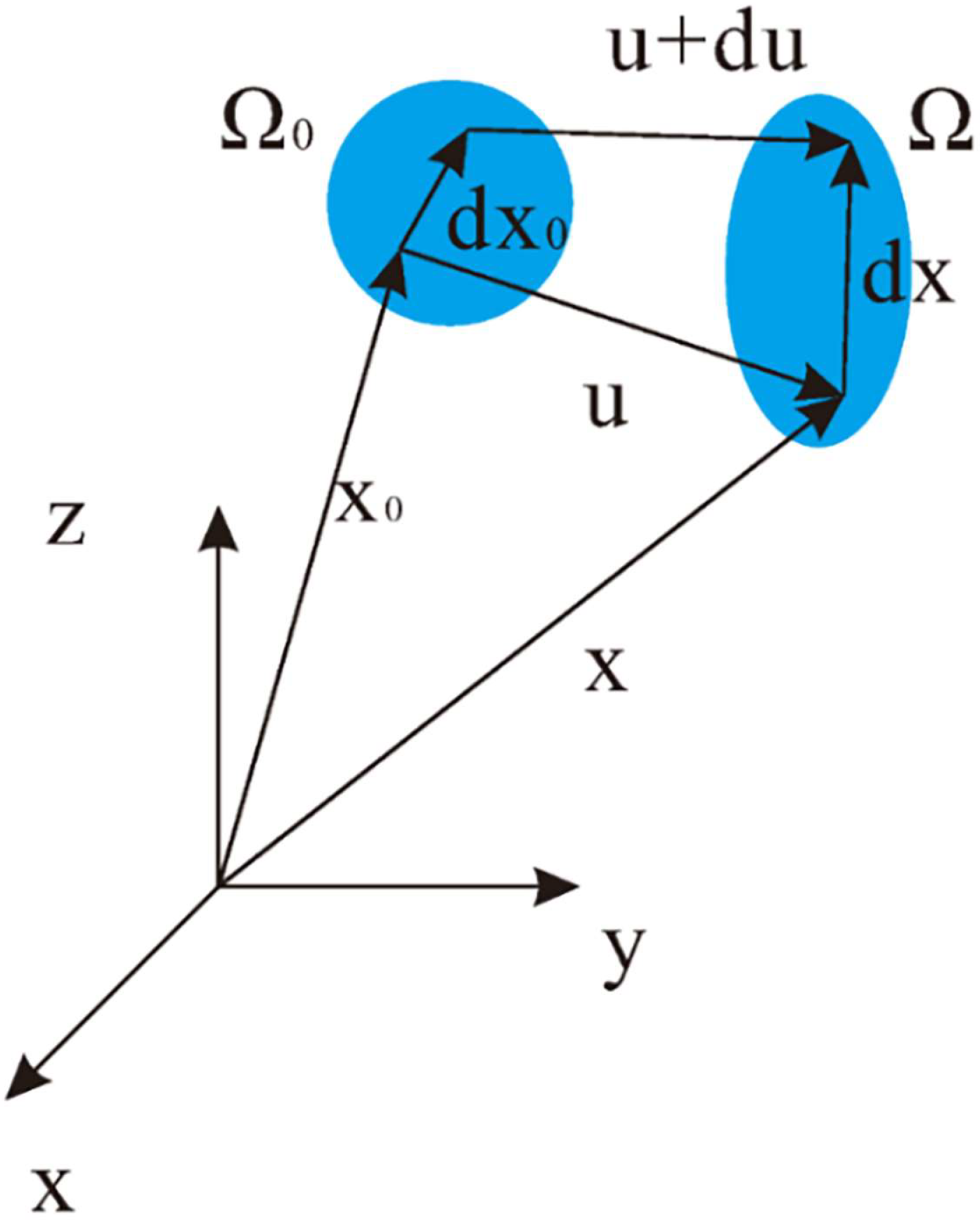
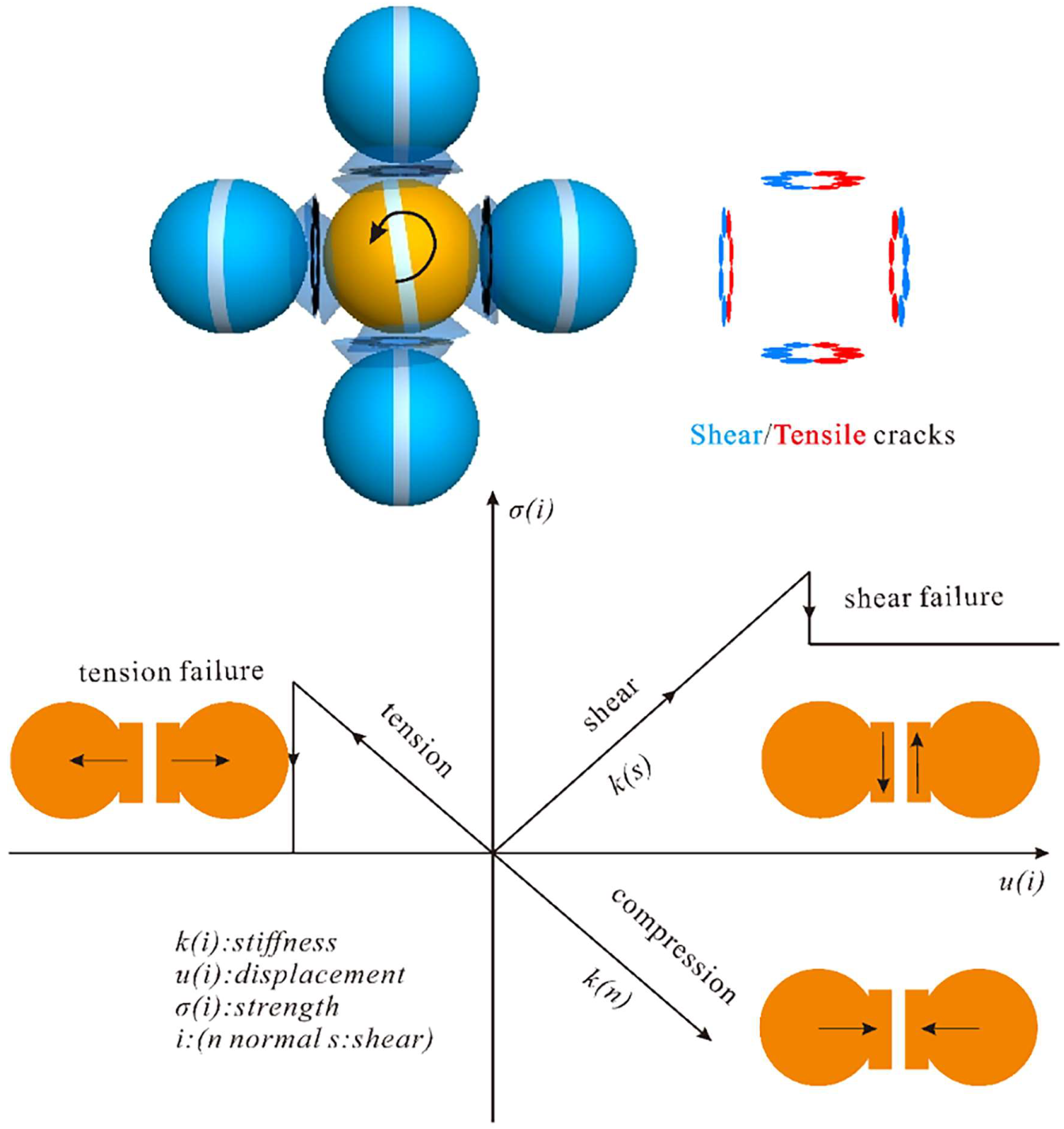
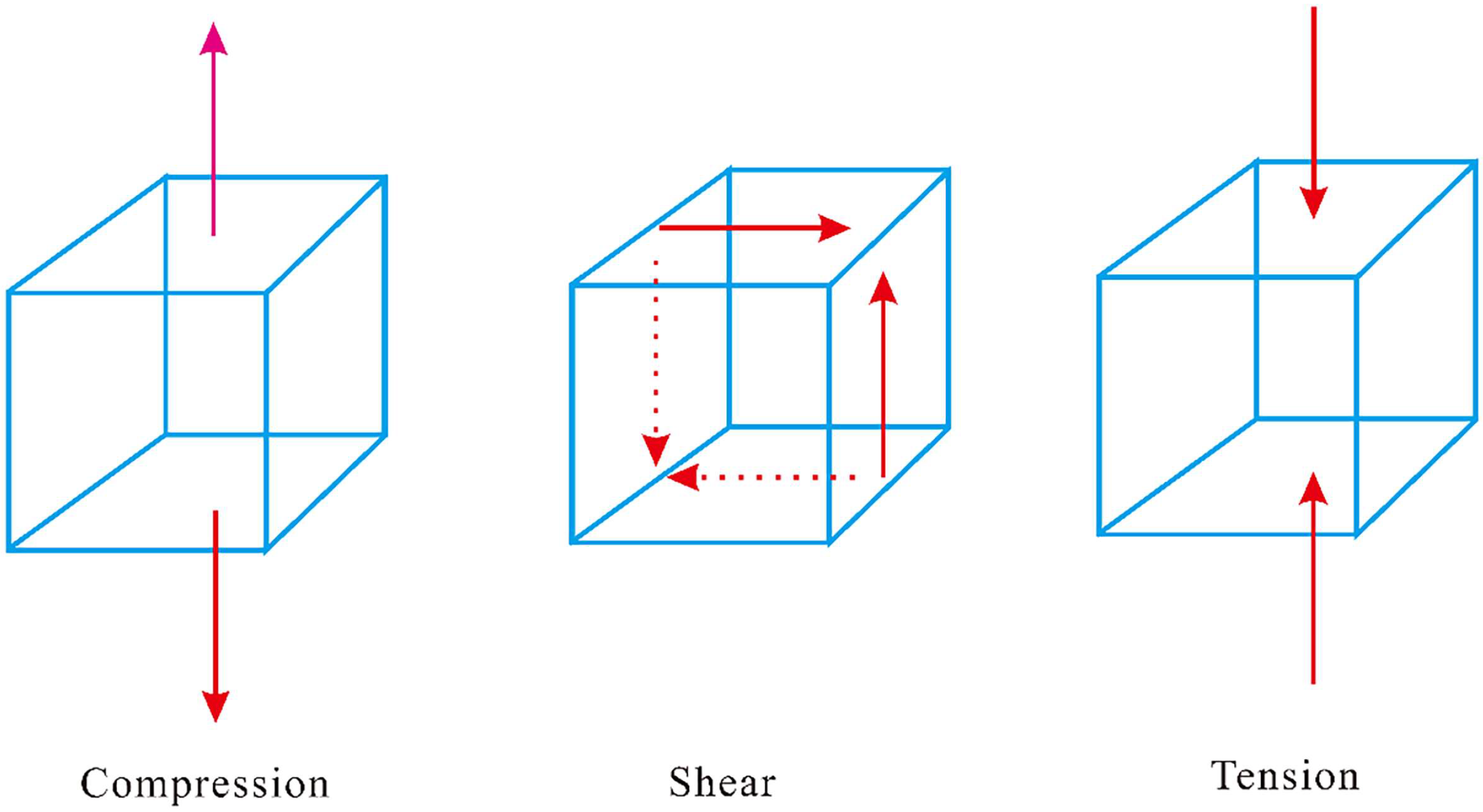


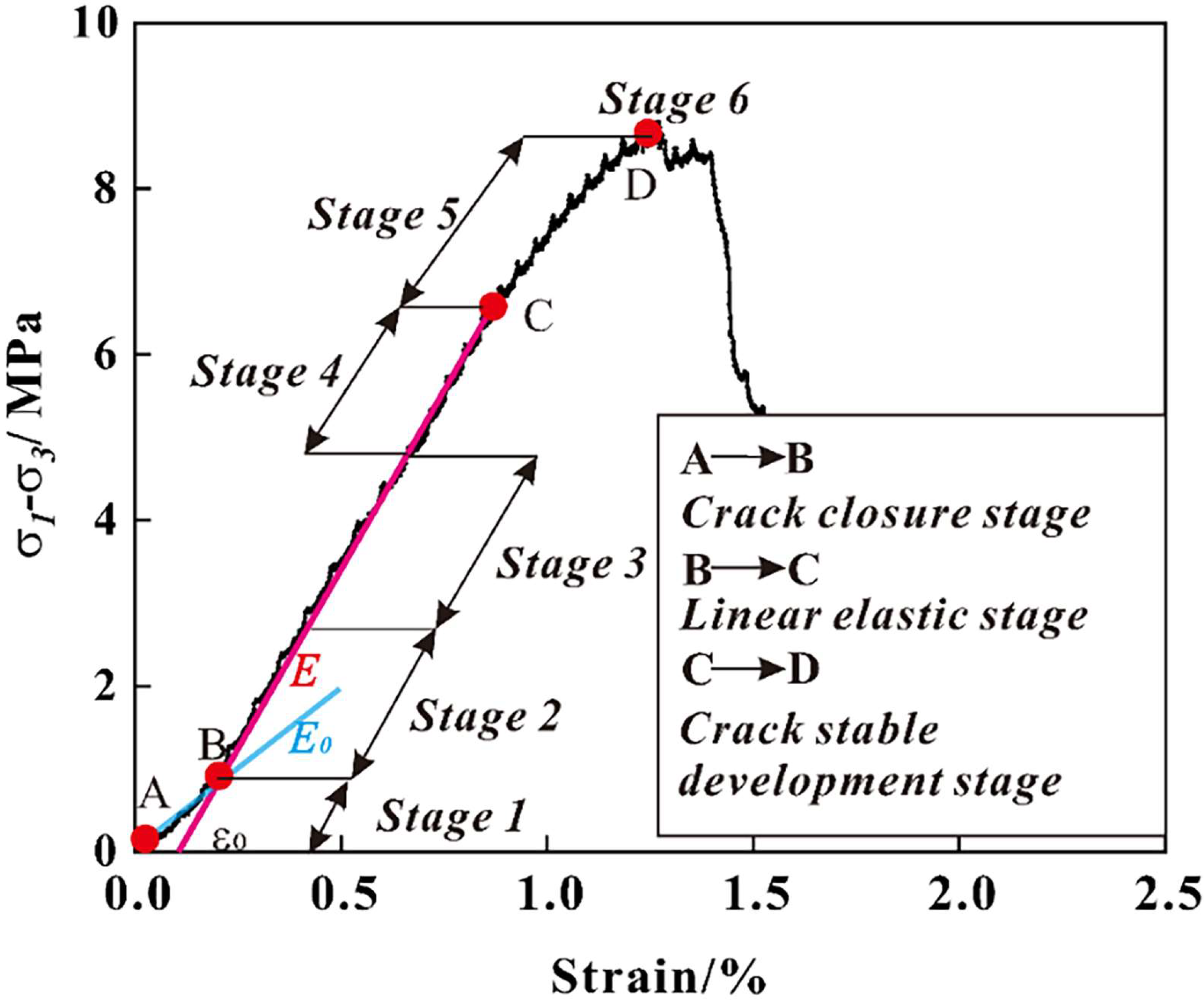
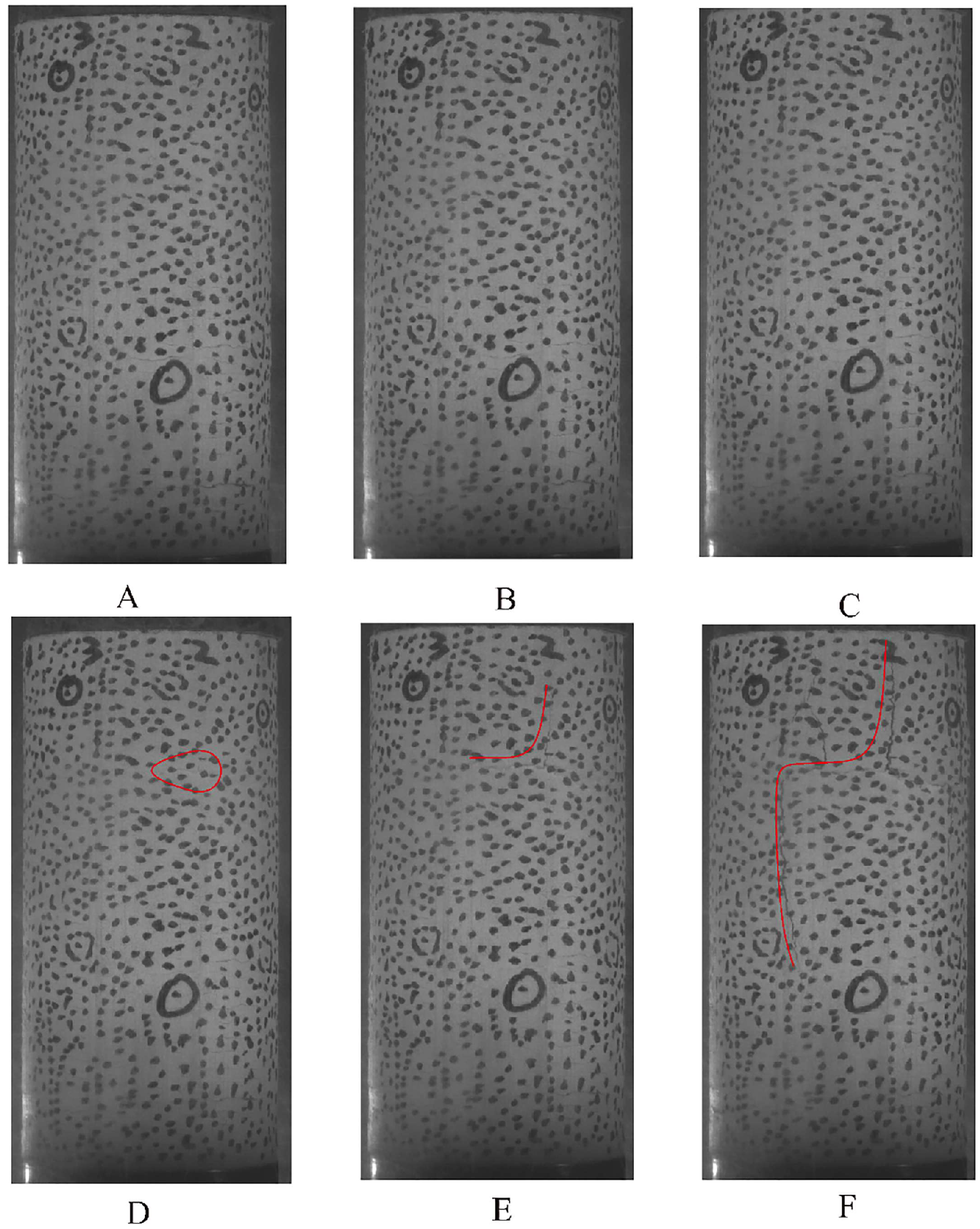

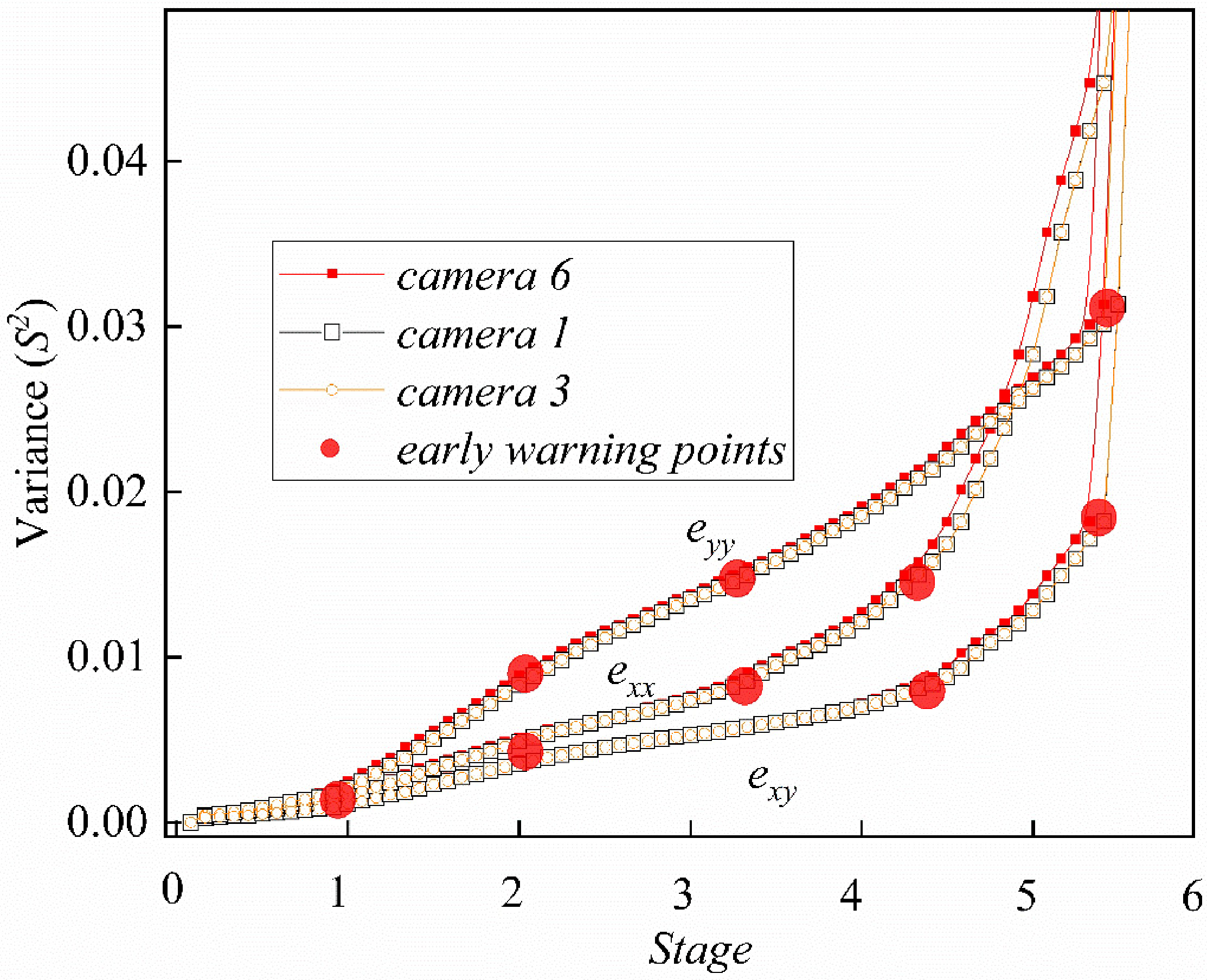
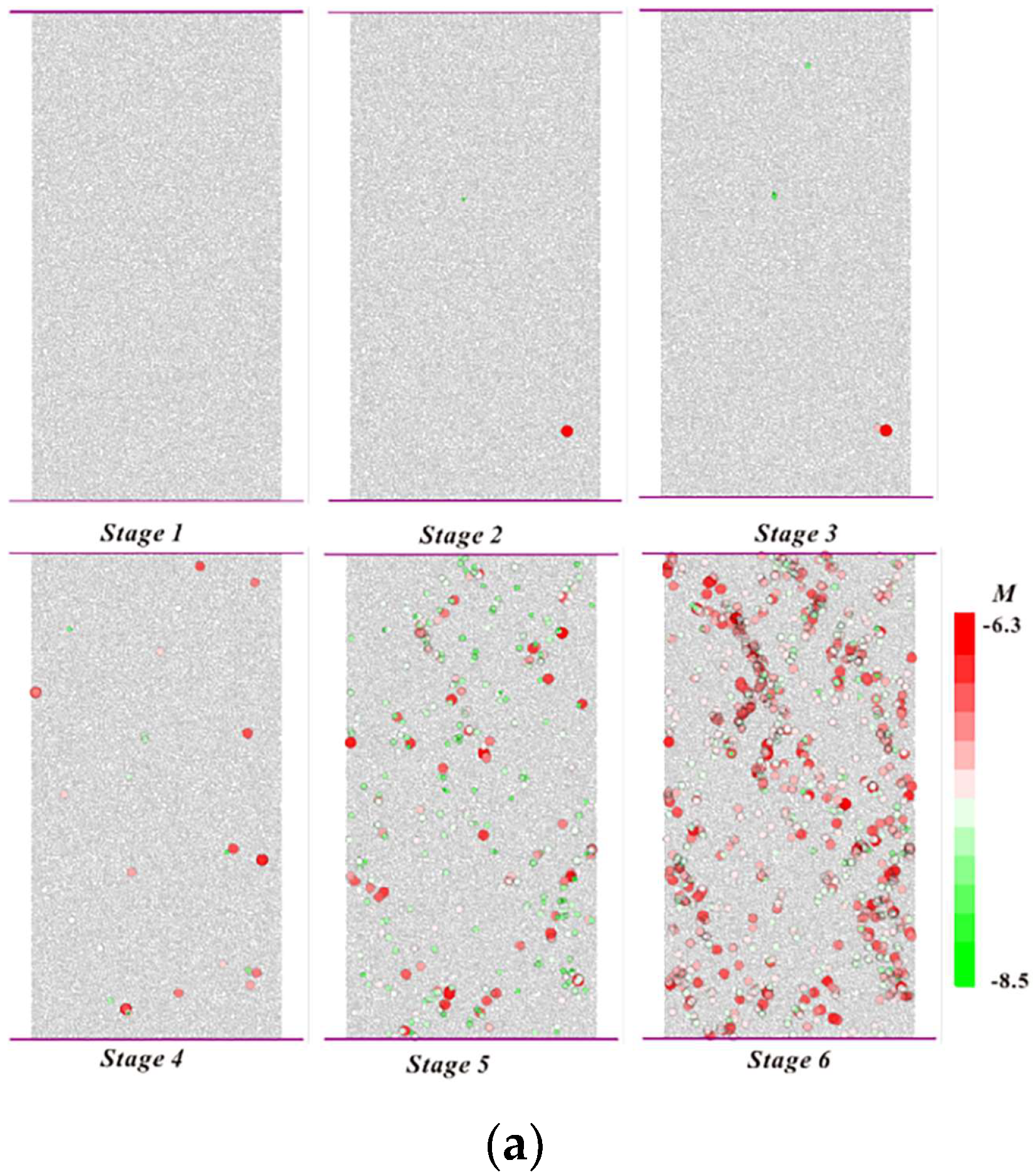
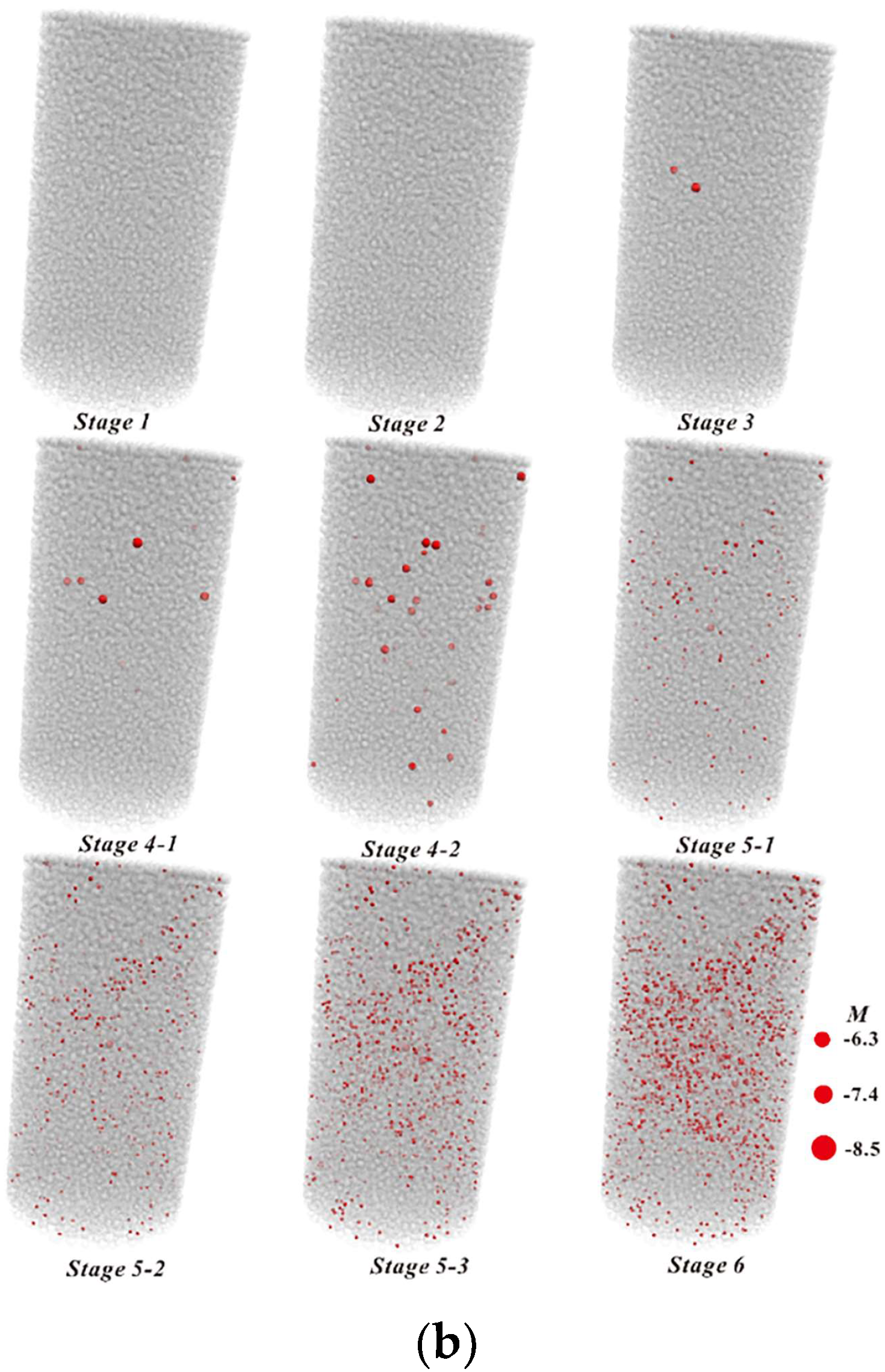
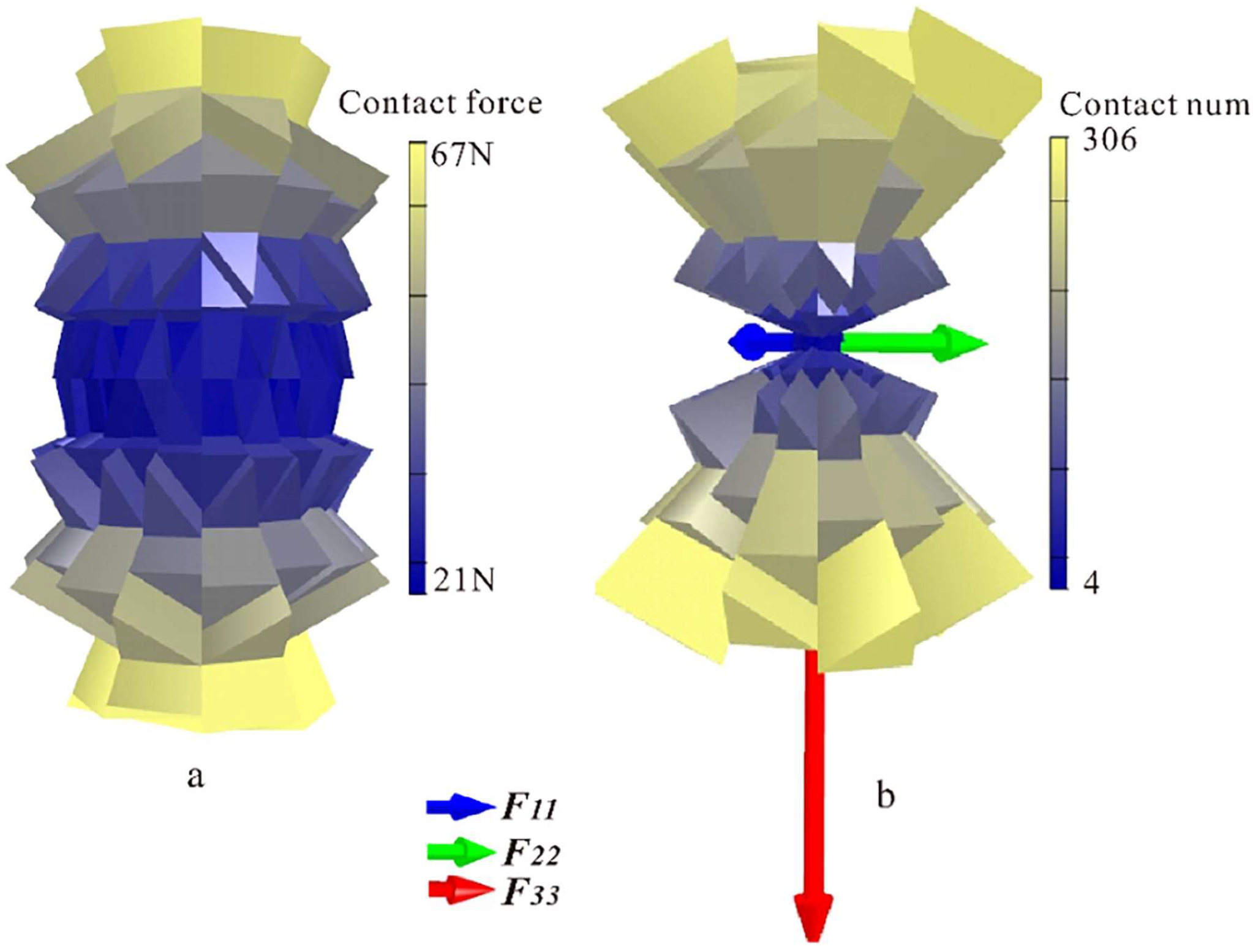

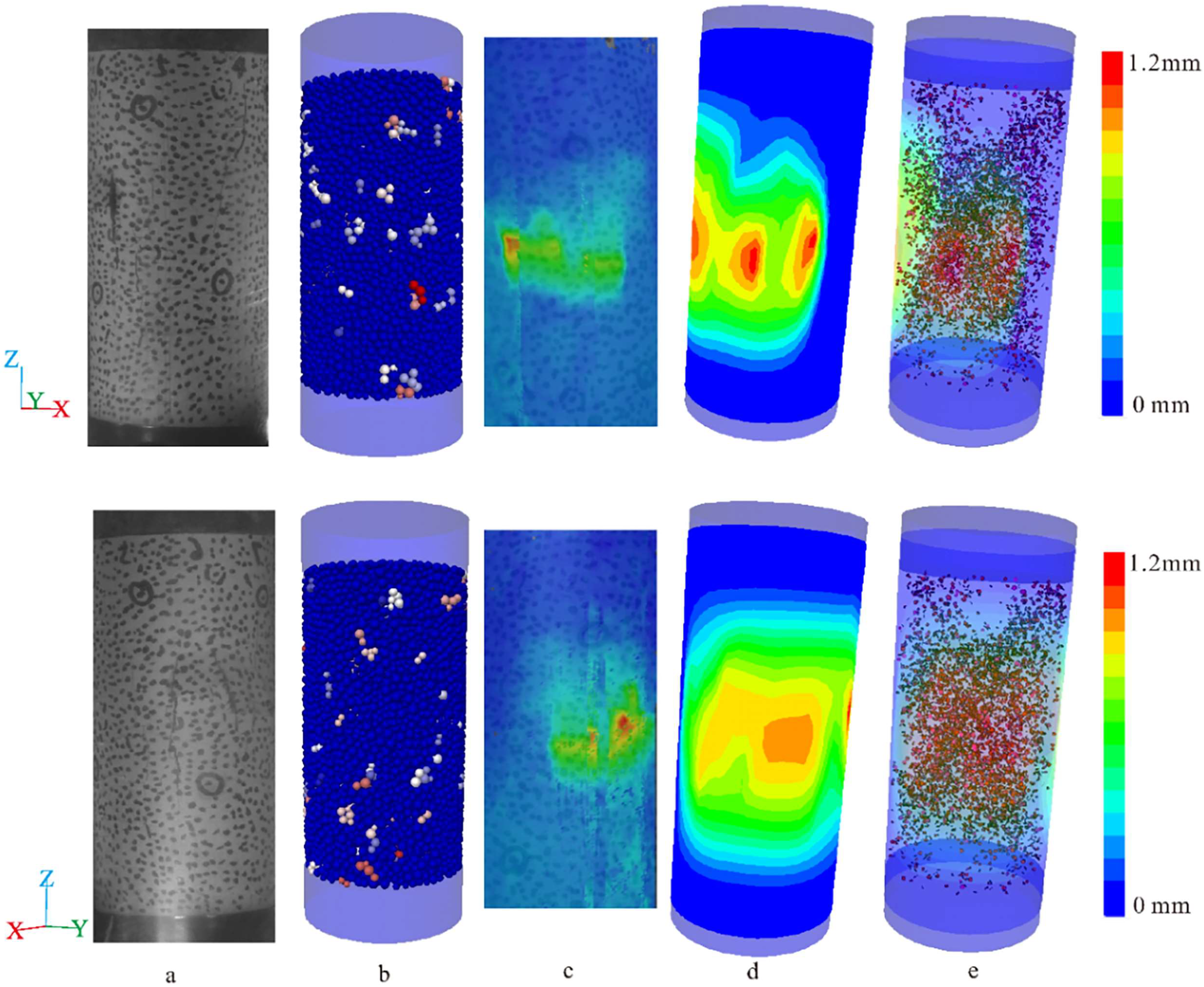
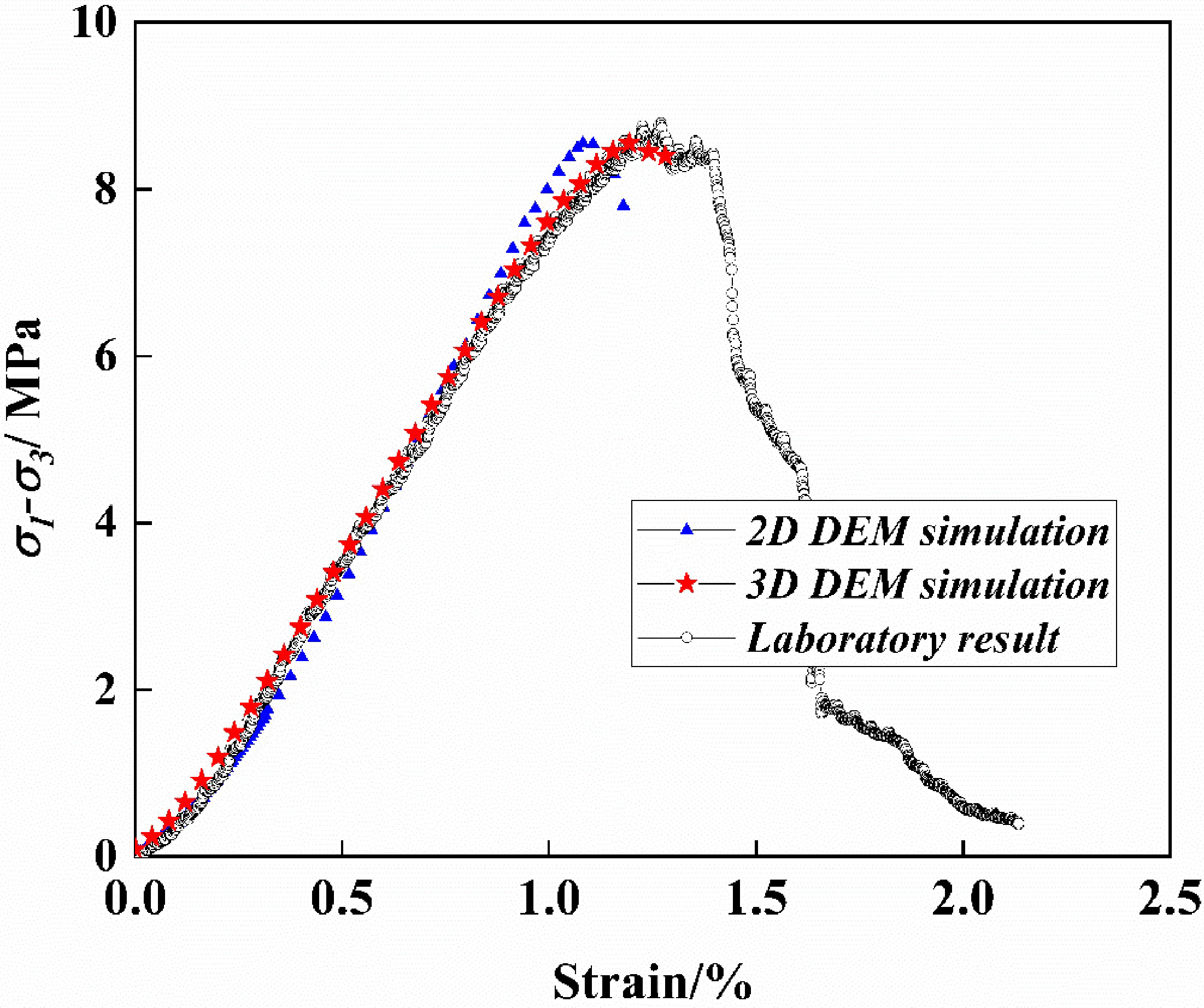


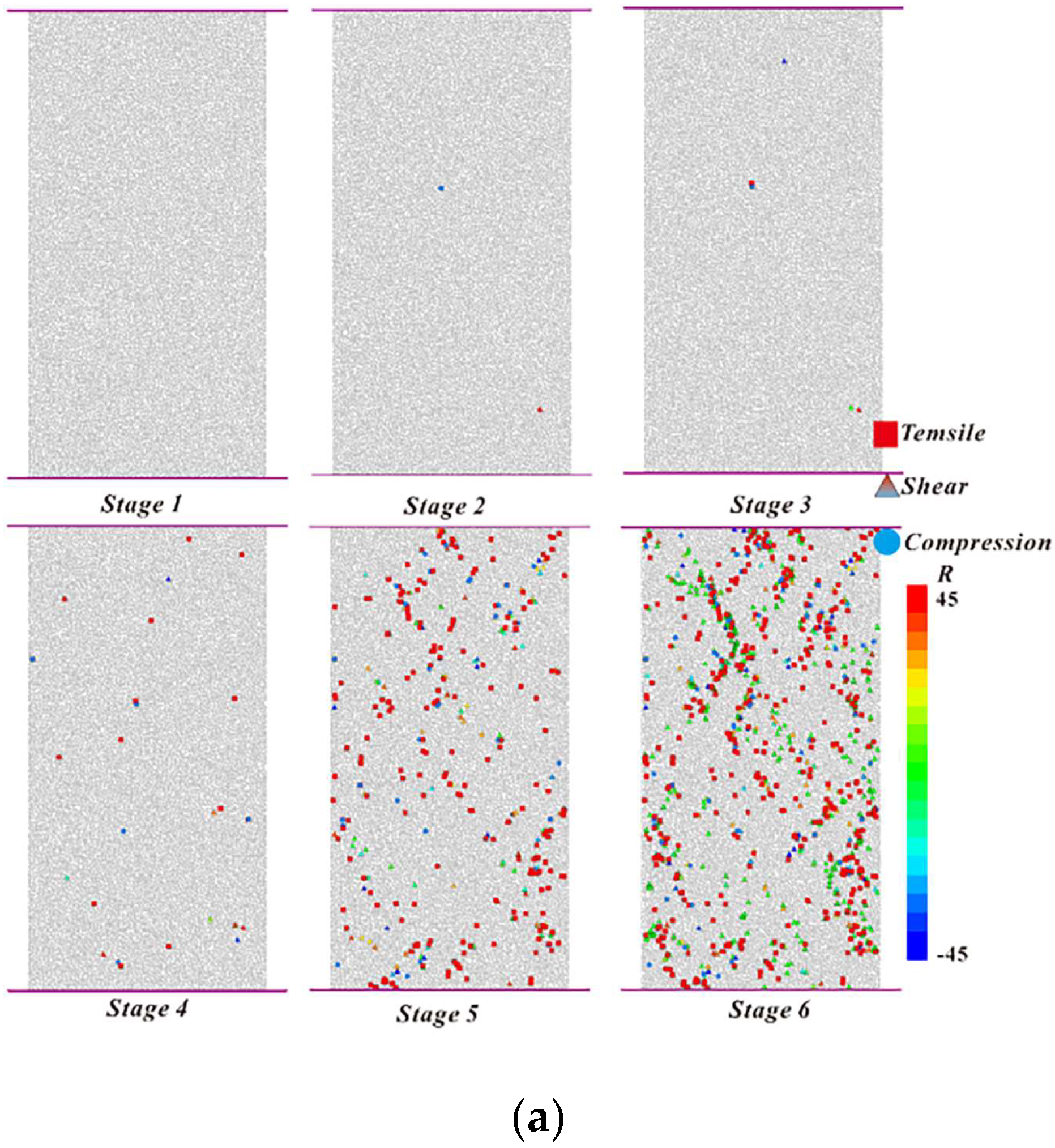

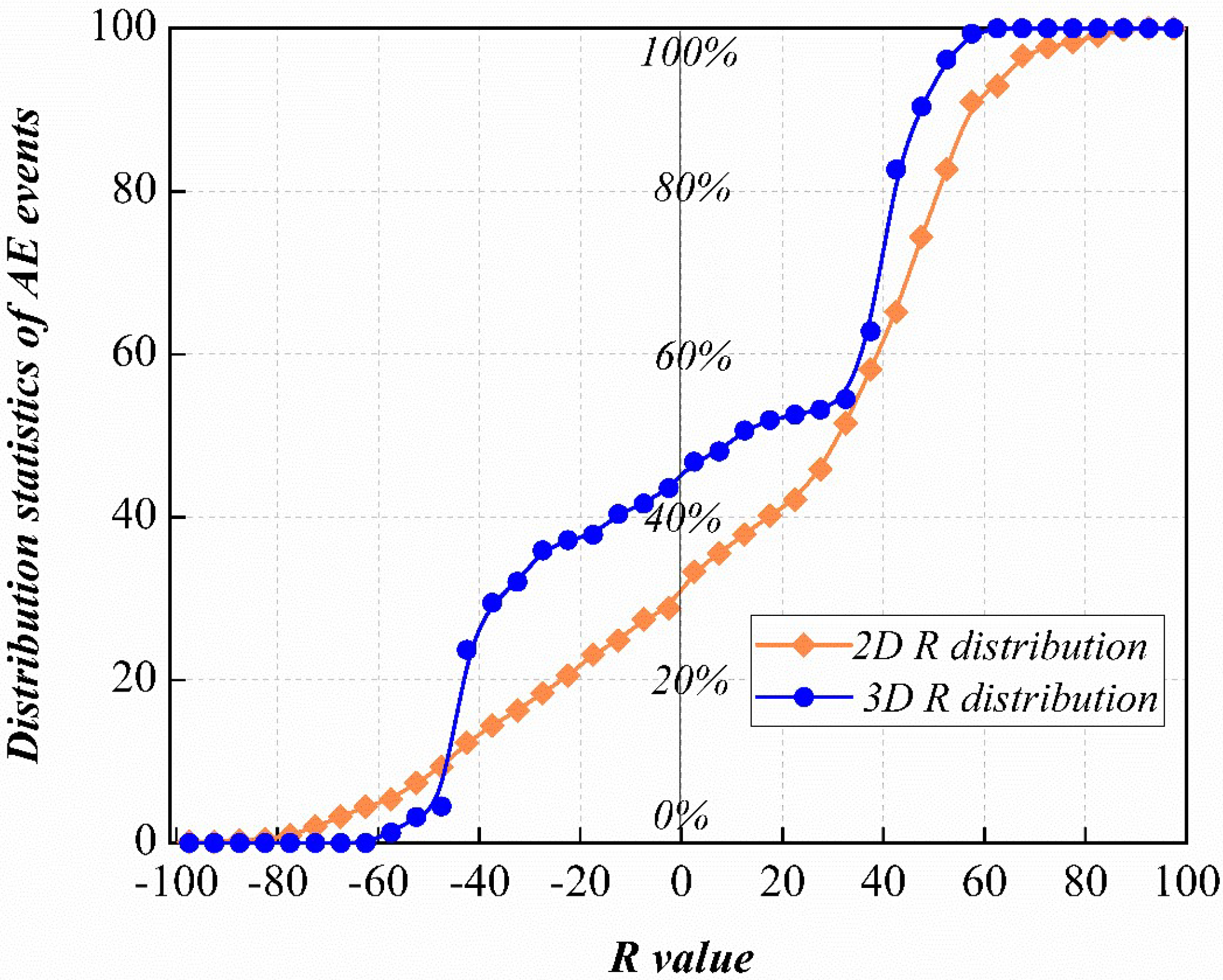
| Failure Mechanism | m | R |
|---|---|---|
| Compression | −42.86 | |
| Pure shear | 0 | |
| Tension | 42.86 |
| Test Sample | 2D DEM Sample | ||||||||||
|---|---|---|---|---|---|---|---|---|---|---|---|
| Strength/MPa | E/MPa | E0/MPa | /MPa | Cohesion/MPa | Friction Angle | k Ratio | u | Damp Ratio | Width/mm | Height/mm | Mean Radius/mm |
| 8.9 | 974 | 342 | 6 | 12 | 20 | 1.2 | 0.3 | 0.5 | 50 | 100 | 0.42 |
| Test Sample | 3D DEM Sample | ||||||||||
|---|---|---|---|---|---|---|---|---|---|---|---|
| Strength/MPa | E/MPa | E0/MPa | /MPa | Cohesion/MPa | Friction Angle | k Ratio | u | Damp Ratio | Width/mm | Height/mm | Mean Radius/mm |
| 8.9 | 974 | 342 | 26 | 40 | 20 | 1.2 | 0.3 | 0.5 | 50 | 100 | 0.81 |
Disclaimer/Publisher’s Note: The statements, opinions and data contained in all publications are solely those of the individual author(s) and contributor(s) and not of MDPI and/or the editor(s). MDPI and/or the editor(s) disclaim responsibility for any injury to people or property resulting from any ideas, methods, instructions or products referred to in the content. |
© 2023 by the authors. Licensee MDPI, Basel, Switzerland. This article is an open access article distributed under the terms and conditions of the Creative Commons Attribution (CC BY) license (https://creativecommons.org/licenses/by/4.0/).
Share and Cite
Xia, C.; Wu, Y.; Cui, G.; Liao, J.; Liu, Z.; Zhou, C. A Coupled Tensor–DEM–FEM Model for the Whole Process of Internal Fine-Scale Damage to Surface Damage in Red-Bed Soft Rocks in the Coastal Area of South China. J. Mar. Sci. Eng. 2023, 11, 1542. https://doi.org/10.3390/jmse11081542
Xia C, Wu Y, Cui G, Liao J, Liu Z, Zhou C. A Coupled Tensor–DEM–FEM Model for the Whole Process of Internal Fine-Scale Damage to Surface Damage in Red-Bed Soft Rocks in the Coastal Area of South China. Journal of Marine Science and Engineering. 2023; 11(8):1542. https://doi.org/10.3390/jmse11081542
Chicago/Turabian StyleXia, Chang, Yongtao Wu, Guangjun Cui, Jin Liao, Zhen Liu, and Cuiying Zhou. 2023. "A Coupled Tensor–DEM–FEM Model for the Whole Process of Internal Fine-Scale Damage to Surface Damage in Red-Bed Soft Rocks in the Coastal Area of South China" Journal of Marine Science and Engineering 11, no. 8: 1542. https://doi.org/10.3390/jmse11081542





